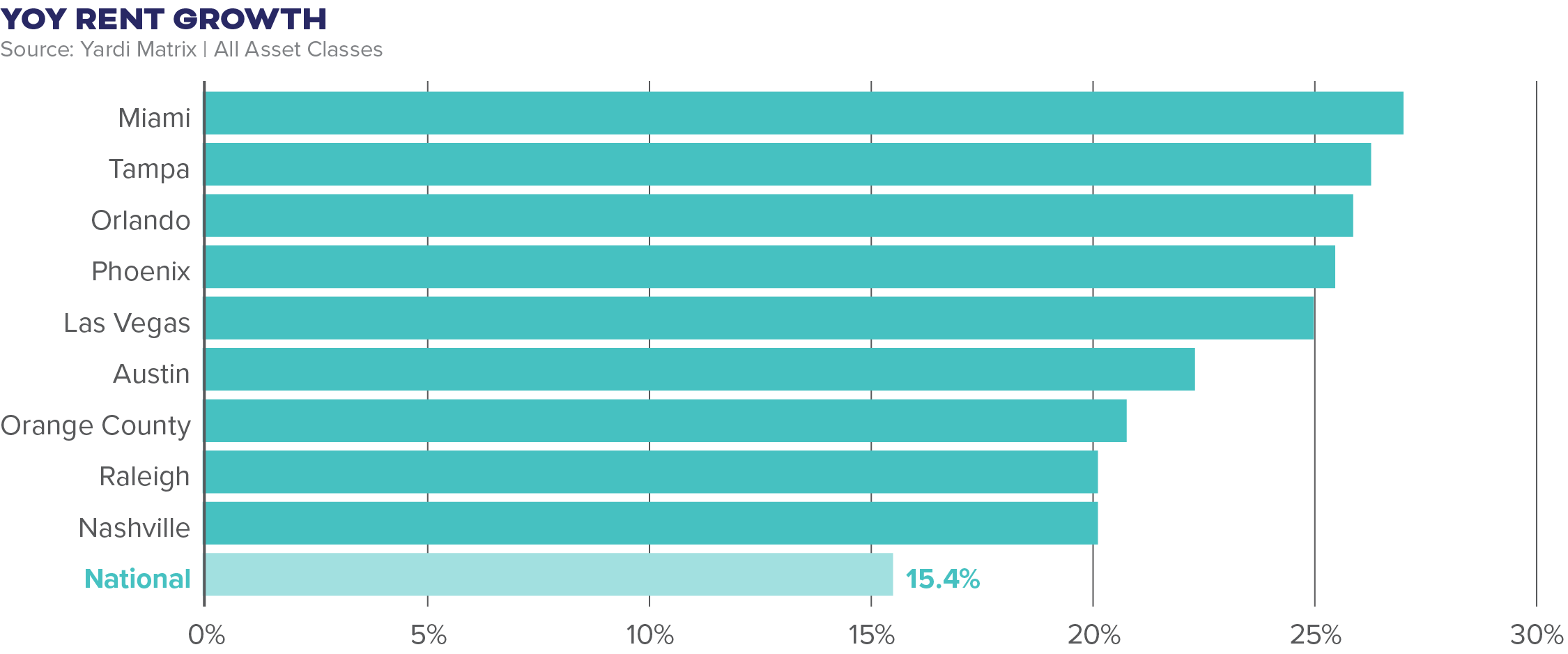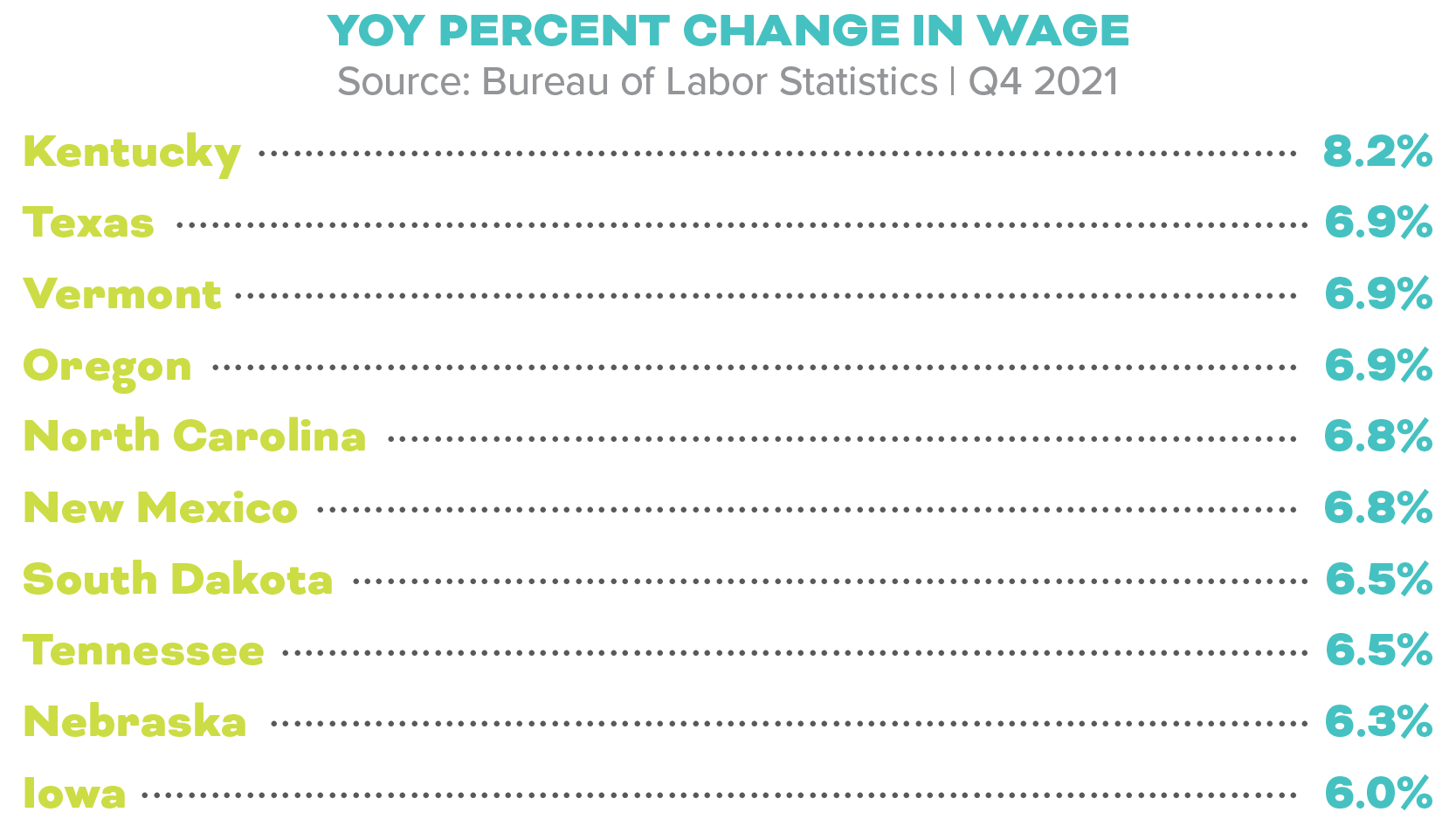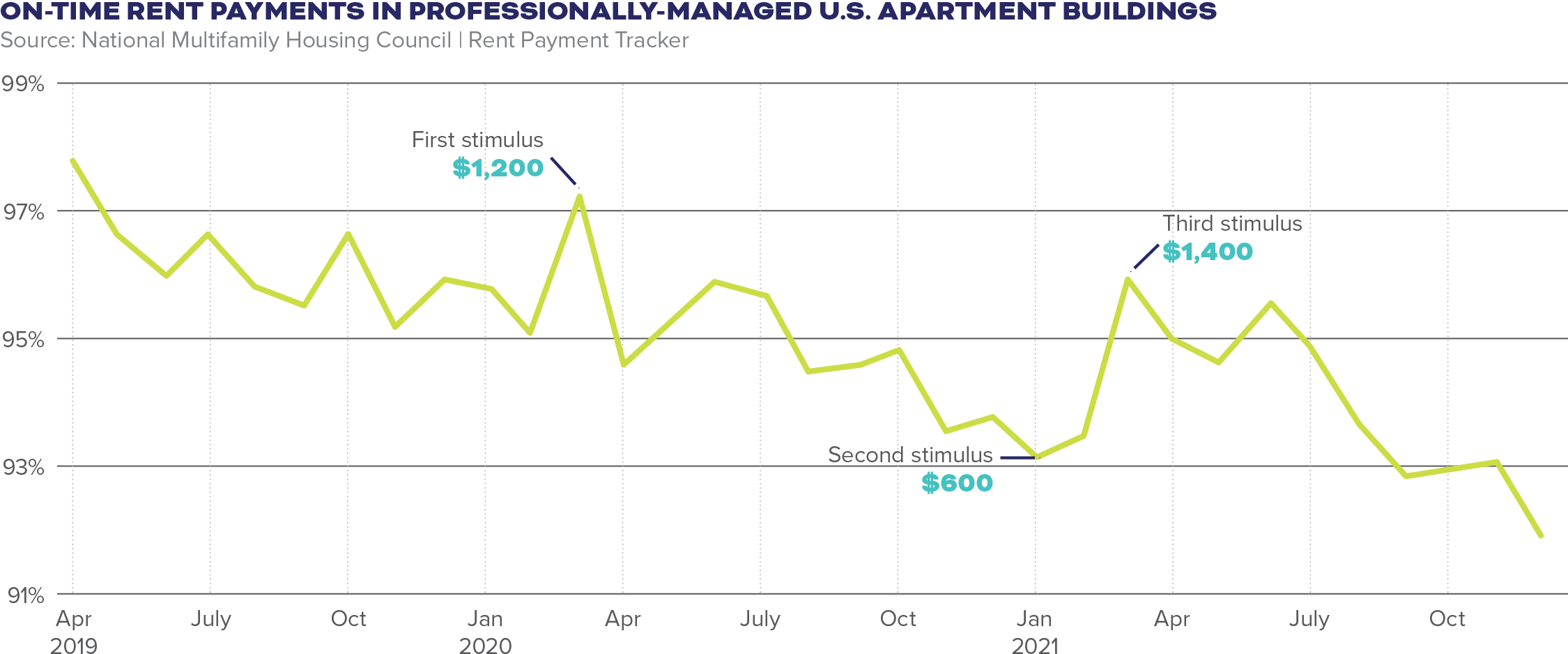Why are Rents Expanding so Quickly?
Renters have changed the trajectory of investors’ expectations for the multifamily sector as they continue to relocate to affordable metros and suburban neighborhoods. Experts largely believed rents would begin to stagger in 2021, but the first three months of 2022 have already outpaced last year’s rent growth. Yardi Matrix reported that 90 percent of the top 30 rental growth markets experienced double-digit growth in February 2022. With the incredible rent performance, investors didn’t want to miss out on capitalizing on these trends. As a result, multifamily transactions reached an all-time high of $198 billion in 2021 and accounted for a third of all commercial real estate investment activity for February 2022. The transaction volumes illustrate investor confidence in the sector and the sustainability of rent growth.
BOOMING RENT GROWTH
In 2020 and 2021, renters redefined apartment demand trends as people migrated to affordable markets with better amenities in the hunt for cheaper rents. Experts assumed that the ever-growing average asking rent reached its limit, with nowhere to go but down. According to Zumper’s National Rent Report, 2021 defied expectations with the sharpest rent increases ever recorded but it’s anticipated that the cap won’t stop there and will continue to climb in 2022. In February 2022, Yardi Matrix reported national asking rents reached a new high of 15.4 percent.

Zumper reported the average national asking rent increased from $1,500 to $1,600 in just seven months and currently sits at $1,628. Rents increased by 20 percent in eight of the top 30 metros and ten percent or more in 90 percent of the top 30 markets. Among the top 30 metros, 90 percent witnessed double-digit growth between ten to 27 percent. The most notable markets include Miami (27 percent), Tampa (26.2 percent), Orlando (25.9 percent), Phoenix (25.4 percent), Las Vegas (24.8 percent), and Austin (22.2 percent). The slowest growth recorded was in the Twin Cities, with rent gains of 5.3 percent.
The most rapid period of growth in 2021 came from May to October, when the median one-bed rent rose by a shocking 9.7% in just six months. Source: Zumper
FACTORS SUPPORTING RENT GROWTH
1. Single-Family Housing Shortage
Multifamily experts did not anticipate rent gains to continue, but the sustained growth exposes the long-term shortage of housing supply. According to the S&P Chase-Shiller Index, single-family home prices jumped 18.8 percent in 2021. Robust multifamily absorption continues in nearly every market, resulting in high occupancies, at 95 percent, in 28 of the top 30 metros.
2. Relocation To Sunbelt Cities
The Sunbelt boasts affordability, so during the global pandemic, the area saw high levels of migration as housing costs rapidly rose. With the world adopting telework practices, people were taking advantage of the ability to live and work anywhere in the nation. Of the 30 metros that saw the most substantial rent gains, 19 of them are located in the Sunbelt region, reporting gains between nine and 27 percent.
3. Increased Wages
In 2021, wages across all industries increased as employers boosted pay and minimum wages in response to labor shortages. According to the Bureau of Labor Statistics (BLS) data, year-over-year wage growth averaged 4.5 percent in the U.S. during Q4 2021. Wages increased the most in Kentucky, Texas, and Vermont. The most noteworthy increase occurred for restaurant and supermarket employees, where minimum wages rose above $15 an hour for the first time.

4. Government Stimulus
The U.S. government provided citizens with federal stimulus checks to relieve many Americans who were financially impacted by COVID-19. With these stimulus payments, renters could make rent or catch up on missed rent payments due to their apartment landlords. Despite eviction moratoriums in place, 95.1 percent of renters still submitted rent for the duration of 2020, and an average of 94 percent of renters submitted payments throughout 2021, according to NMHC’s Rent Payment Tracker data.

FACTORS SUPPORTING FUTURE GROWTH
In the first three months of 2022, national rent growth is outpacing 2021. While the inflating rents are favorable for investors, the question at the top of everyone’s mind is – is this growth sustainable?
1. Government Stimulus Burning Off & Expiring Eviction Moratoriums
Amid the pandemic, apartment landlords were flexible with renters, allowing partial payments or other methods. With the last federal stimulus check distributed in March 2021, it’s been over a
year since government relief has contributed to rental payments. With continuous favorable rent submissions throughout 2021, this shows that renters can make payments again without government aid. Further, nationwide eviction moratoriums have, for the most part, expired, resulting in the eviction of renters unable to make payments.
2. Rents Outpacing Wage Growth
Though wage growth contributed to expanding rents, wages are not keeping pace with rents. Moody’s Analytics experts say the median household now dedicates over a quarter of their income to rent, with rent-to-income ratios increasing more than 30 percent in Q4 2021 for expensive metros.
3. Limited Supply Of Inventory
Only two of the top 30 apartment markets had occupancy rates below 95 percent, according to Yardi Matrix. With occupancies at all-time highs, renters have limited availability to choose from, thus discouraging move-outs. This means that many people renew their leases and choose not to move, giving landlords continued pricing power.
4. Rising Inflation & Interest Rates
The increasing costs of everyday items, such as groceries and gas, have fed into rent growth. Real estate often grows in value during inflationary periods, allowing landlords to adjust rents according to current market conditions. Further, the climbing interest rates discourage renters from house hunting. Pair that with the severe affordable housing shortage, renters are likely to ride out the inflation storm.
The current market conditions are favorable for apartment landlords, as renters are priced out of single-family homes and continue to rent. Though it is widely believed that these rent gains are not sustainable, the current market fundamentals have given landlords pricing power.










